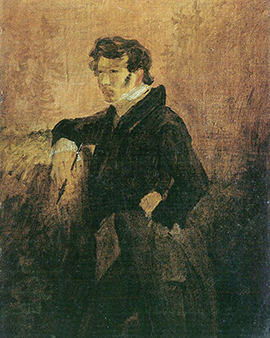Carl Blechen's overwhelming success as a painter was not necessarily in his cradle: his parents had nothing whatsoever to do with art or painting. His father was a tax official and the family lived in modest circumstances. Carl Blechen was born in Berlin in 1798. During his time at the Gymnasium, he had lessons with the well-known painter Ch. G. Lemmrich, who recognized his potential.
Unfortunately, Blechen's parents did not have the means to let their son study, so he began an apprenticeship as a bank clerk and also worked in this profession. On the side, however, he always devoted himself to painting. Finally, at the age of 24, he took up studies at the Berlin Academy of Arts. After completing his studies, he got a permanent job as a decorative painter at the Königsstädtisches Theater in Berlin, but lost it again due to personal disputes. He became a freelance artist and traveled the Baltic coast and especially Italy. He brought home over 500 sketches, after which he created his paintings.
People became aware of him and at the age of 33 he was appointed professor of landscape painting at the Berlin Academy. He continued to travel, paint and teach, but increasingly obvious was his failing health. He had severe mental problems and suffered from recurrent depression. Eventually he was given a leave of absence from the Academy. His last journey took him to Dresden and it was from there that his last drawing was made.Blechen did not regain his health. He died on July 23, 1840 in mental derangement.
Our idea of Romanticism in painting is shaped by Caspar David Friedrich and includes wild romantic landscapes, dramatic moods, gnarled trees and weathered castles. All these ingredients are also found in Carl Blechen's work, but unlike the early Romantics, he did not create fairy-tale or heroic settings. His landscapes depict reality, are more drastic and at the same time more sober. In his light and color effects, he achieves moods that are already reminiscent of the Impressionists. This way of depicting nature was quite controversial at the time, but his work was groundbreaking.
×





.jpg)
.jpg)
_-_(MeisterDrucke-69237).jpg)
_-_(MeisterDrucke-69237).jpg)
.jpg)
.jpg)
.jpg)
.jpg)
.jpg)
.jpg)
_Peinture_de_Carl_Blechen_(1798_-_(MeisterDrucke-1031264).jpg)
_Peinture_de_Carl_Blechen_(1798_-_(MeisterDrucke-1031264).jpg)
.jpg)
.jpg)
.jpg)
.jpg)
.jpg)
.jpg)
.jpg)
.jpg)
.jpg)
.jpg)
.jpg)
.jpg)
.jpg)
.jpg)
.jpg)
.jpg)
.jpg)
.jpg)
.jpg)
.jpg)
.jpg)
.jpg)
.jpg)
.jpg)
.jpg)
.jpg)
.jpg)
.jpg)
.jpg)
.jpg)
.jpg)
.jpg)
.jpg)
.jpg)
.jpg)
.jpg)
.jpg)
.jpg)
.jpg)
.jpg)
_-_(MeisterDrucke-1420079).jpg)
_-_(MeisterDrucke-1420079).jpg)
.jpg)
.jpg)
.jpg)
.jpg)
.jpg)
.jpg)
 - (MeisterDrucke-61277).jpg)
 - (MeisterDrucke-61277).jpg)
.jpg)
.jpg)
.jpg)
.jpg)
.jpg)
.jpg)
.jpg)
.jpg)
.jpg)
.jpg)
_oil_25x33_cm_-_(MeisterDrucke-1463286).jpg)
_oil_25x33_cm_-_(MeisterDrucke-1463286).jpg)
_-_(MeisterDrucke-688761).jpg)
_-_(MeisterDrucke-688761).jpg)
.jpg)
.jpg)
.jpg)
.jpg)
.jpg)
.jpg)
.jpg)
.jpg)
.jpg)
.jpg)
.jpg)
.jpg)
.jpg)
.jpg)
.jpg)
.jpg)
.jpg)
.jpg)
.jpg)
.jpg)
.jpg)
.jpg)
.jpg)
.jpg)
.jpg)
.jpg)
.jpg)
.jpg)
.jpg)
.jpg)
.jpg)
.jpg)
.jpg)
.jpg)
.jpg)
.jpg)
.jpg)
.jpg)
.jpg)
.jpg)
.jpg)
.jpg)
.jpg)
.jpg)
.jpg)
.jpg)
_Peinture_de_Carl_Blechen_(1798-18_-_(MeisterDrucke-939169).jpg)
_Peinture_de_Carl_Blechen_(1798-18_-_(MeisterDrucke-939169).jpg)
.jpg)
.jpg)
.jpg)
.jpg)
.jpg)
.jpg)
.jpg)
.jpg)
.jpg)
.jpg)
.jpg)
.jpg)
.jpg)
.jpg)
.jpg)
.jpg)
.jpg)
.jpg)
.jpg)
.jpg)
.jpg)
.jpg)
.jpg)
.jpg)
.jpg)
.jpg)
.jpg)
.jpg)
.jpg)
.jpg)
.jpg)
.jpg)
.jpg)
.jpg)
.jpg)
.jpg)
.jpg)
.jpg)
.jpg)
.jpg)
.jpg)
.jpg)






